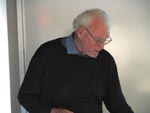Research Activities >
Programs >
Nonequilibrium Interface and Surface Dynamics 2007
|
|
Chemical potential for nucleation of surface
islands using beams of self-ions
CSIC Building (#406),
Seminar Room 4122.
Directions: home.cscamm.umd.edu/directions
|
Chemical potential for nucleation of surface islands
using beams of self-ions
Professor
Peter Flynn

University of Illinois, Urbana-Champaign
|
|
Abstract:
On an existing low energy electron microscope
(LEEM), built by Tromp, we have installed an accelerator that provides intense
beams of negative self-ions at normal incidence to the LEEM sample. At low ion impact energies the beam yields epitaxial (hypothermal) growth and drives the chemical potential m* positive. Above a 'neutral' impact energy at which the
beam creates only surface Frenkel pairs, the beam
erodes the surface and drives m*
negative. On large terraces, 6-10mm in radius,
created by ion beam methods to be described, we have investigated the ion beam
intensity needed to nucleate and grow single new adatom and advacancy islands. From the measured beam intensities, the value
of m* needed
for nucleation is determined for both adatom and advacancy islands. Since the surface adatom and advacancy defects are strongly reacting, the interpretation
that links intensity to chemical potential employs a recent theory[1]
in which a single m*
describes the reactivity of both species of antidefect. We obtain a global prediction that nucleation
in the two cases occurs for approximately equal but opposite changes of m* caused by ion
beams. In experiments on Pt(111) using Pt- ions with impact energies of 50 eV and 500 eV for growth and
erosion, respectively, in the temperature range 800K < T < 1000K, the
predicted symmetry between the islands formed from the two antidefects is clearly demonstrated. Moreover, the
magnitude of m*
required to drive nucleation through ion beam irradiation is within 30% of the
value predicted by Pimpinelli and Villain in an
earlier treatment of sublimation[2].
[1] C P Flynn, Phys Rev B71, 085422
(2005).
[2] A Pimpinelli and J Villain, Physica A204, 521 (1994).
* Research supported by the Department of Energy. |
|